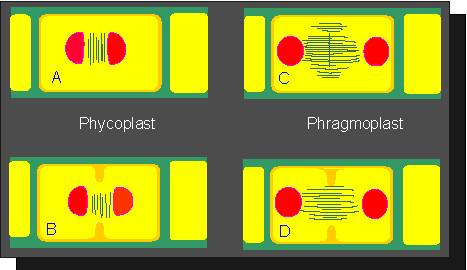- Appearance: mostly bright green, because chlorophyll is little masked by accessory pigments; some species cause reddish discoloration of water and snow
- Organisation: from unicells, filaments, coenobia to large macroalgal thalli, some siphonaleous forms (multinucleate)
- Distribution: freshwater, marine, soils
- Calcium carbonate precipitation (e.g. Halimeda) produces substantial carbonate sand in tropical shallow regions
- Use of green algae: production of organic compounds (Haematococcus, Dunaliella), human food supplement (Chlorella, Ulva), bioassays for water pollution (Selenastrum), genetic research (Acetabularia, Chlamydomonas, Volvox), electrophysical research (Chara)
- Endosymbionts in freshwater animals (Chlorella) and lichens
- Evolutionary origin: monophyletic
- Phylogeny of green algae is not related to morphological groups, i.e. similarly appearing species (e.g. coccoid) are not closely related and differently appearing species are closely related
- Three major lineages in the chlorophytes:
- Charophyceans: named after the stonewort Chara, multicellular, multilayered thalli, but also filamentous forms (Zygnema, Spyrogyra); closest related to higher plants
- Ulvophyceans, Trebouxiophyceans, Chlorophyceans: referred to as UTC clade; contain multicellular, multilayered thalli (Ulvophyceans) as well as filaments and unicellular forms
- Prasinophyceans: unicellular group
- Colorless, phagotrophic flagellates related to the chlorophytes (as evolutionary early ancestors) are unknown
- Phototrophy is common to almost all green algae
- Photoheterotroph species supplement photosynthesis by osmotrophic uptake of dissolved organic carbon (mixotrophy), but only when light is present and photosynthesis becomes nutrient limited
- Flagella occur in multiples of two and lack tripartite hairs, mostly equal length
- Plastids possess two membranes (primary plastids); chlorophyll a, b in thyllakoids
- Storage product is starch inside the plastids (often in pyrenoid), which is unique to chlorophytes; stains with iodine (best way to identify algae as chlorophytes)
- Eye-spots, if present, are located inside the plastid, not outside such as in euglenophytes, dinophytes
- Plastid forms are diverse, but uniform within one given genus (taxonomic marker)
- Centrioles are generally present in chlorophytes to organize the division spindle of microtubuli
- Closed mitosis: nuclear envelope remains intact (Ulvophyceans)
- Metacentric mitosis: centrioles are located near the metaphase plate of chromosomes rather than at the spindle poles
- Open Mitosis: nuclear envelope breaks down early in mitosis (Charaphyceans and in higher plants)
- Phycoplast: chlorophyceans with well-developed cell wall produce a set of microtubuli (phycoplast) parallel to the plance of cell division; separates daughter nuclei
- Plasmodesmata (plasma connection between cells) develop from the phycoplast
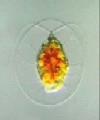
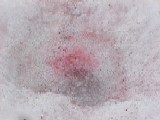

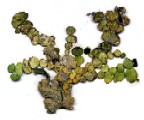
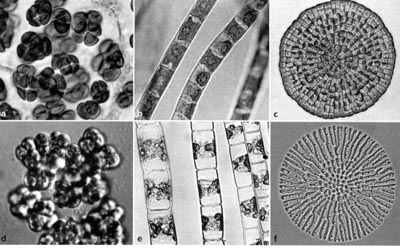
Upper row: Charophyceans
Lower row: chlorophycean, ulvophycean, ulvophycean
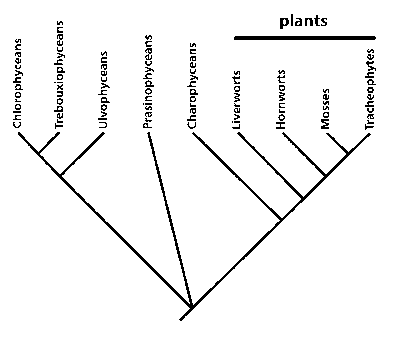
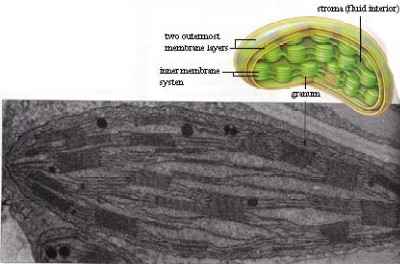
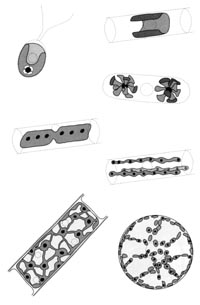
 closed,
metacentric, open mitosis
closed,
metacentric, open mitosis
Phragmoplasts are found in the higher Charo- phyceae; different from phycoplasts in that phragmoplasts contain double-microtubuli
